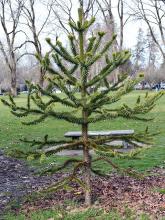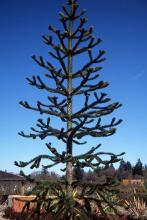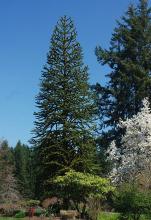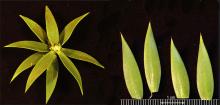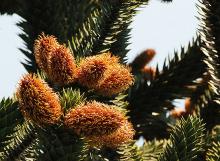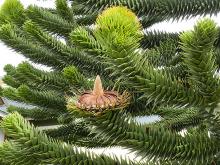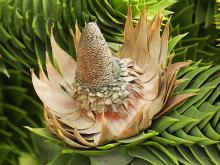Araucaria araucana
Common name:
Monkey Puzzle Tree
Chilean Pine
Pronunciation:
a-row-KAH-ree-a a-row-KAH-na
Family:
Araucariaceae
Genus:
Type:
Broadleaf
Native to (or naturalized in) Oregon:
No
- This evergreen tree is a conifer but it has rather broad leaves and so it is included under this search system. The tree in its native habitat is 50-80 ft (15-25 m) tall and 22-30 ft (7-10 m) wide, about half that size under cultivation, spreading branches, conical when young, rounded with age. Bark is gray with horizontal folds, recalls a wrinkled elephant hide. Leaves simple, alternate, spirally arranged and closely set and completely obscuring the stem, ovate-lanceolate, spiny pointed, stiff, about 3-5 cm long and 0.8-2.5 cm wide at the base. They may persist for 10-15 years. Sometimes both male and female flowers are on the same tree (monoecious), but it is usually dioecious - male and female trees; the sex of a tree cannot be determined until flowering. Female cones are ovoid, 10-18 cm long by 8-15 cm wide, pineapple-shaped, 2-3 years to mature; seeds bright brown to orangish, edible and sold in local Chilean markets. Male cones are ovoid to cylindrical to 15 cm long, borne in clusters at the ends of shoots.
- Sun. Tolerant of many soil types, maritime exposures, and salt-laden winds, and it thrives in cool, mild climates. Impressive "skyline trees".
- Hardy to USDA Zone 7 (The hardiest of the araucarias.) Native to the volcanic slopes of the Andes on the Chilean side, also into Argentina. The national tree of Chile.
- Monkey Puzzle: reportedly the comment, it would "puzzle a monkey to climb this tree", gave rise to the common name.
- araucana: after the Arauco Indians of central Chile, whose territory the species A. araucana is native.
- The tree was introduced into nursery commerce by Archibald Menzies (1745-1842), a Scottish physician and naturalist, who served as naturalist and surgeon on the ship Discovery on its voyage around the world under Captain Vancouver. Apparently one night, Mr. Menzies was dining out in Chile and was unable to identify some nuts on the table. He collected a few and germinated some on the voyage home. The resulting, somewhat strange looking, plants quickly found their way into the rare plant collections of 18th century Europe. The tree became something of a fad in Britain in the 1840s.
- Oregon State Univ. campus: on the east side of Community Hall (Benton Hall), also on the southwest corner of Lower Campus, on Jefferson Ave. near 11th St.


